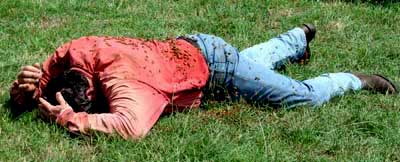EN ESPAÑOL
By John Pint
 The threat of Africanized Honey Bees (AHB) is well
known in Mexico, where the bee population “went African” many years
ago, and where hundreds of humans and animals have been killed by them,
but only recently have people in the United States discovered
the grim reality of an AHB attack. The threat of Africanized Honey Bees (AHB) is well
known in Mexico, where the bee population “went African” many years
ago, and where hundreds of humans and animals have been killed by them,
but only recently have people in the United States discovered
the grim reality of an AHB attack.
Will Baird, a wildlife conservationist and inventor living in Houston,
Texas was deeply affected a few years ago, by the tragic fate of a good
friend. “He was my neighbor and was just about to be married,” says
Baird. “He had a few bee hives on his property and overnight one of
them was Africanized. The next day, my friend began mowing his grass.
As he approached the hives, a cloud of bees poured out and attacked
him. He jumped off the tractor and the mower cut off his legs. It was a
horrible way to die.”
During the following months, Baird decided to seek a way for people to
defend themselves against an attack by Africanized bees. Because the
bees are particularly irritated by the roar and vibrations of motorized
vehicles, Baird first worked on how to protect a tractor driver.
Knowing that bees can’t stand smoke, he tried attaching smoke bombs to
a tractor. This approach failed because the wind either blew the smoke
in the wrong direction or obscured the vision of the driver.
Then Baird had
an inspiration: what about water vapor instead of smoke? He soon found
out that bees have a defensive mechanism to prevent their drowning in a
spray of water. “Bees breathe through their thorax,” he explains, “and
they have waxy hairs around the thorax which make the water bead up, so
the flow of air is unimpeded.”
Baird next searched for a formula that would allow water to bypass the
waxy hairs. Once he found it, he says, he discovered that a spray of
vapor would immediately kill the bees swarming over the body of a
victim under attack and would then hold other bees at bay, allowing the
victim to escape or be rescued.
“At first we thought we needed an awful lot of this liquid,” states
Baird, “but we forgot about the bees’ ability to communicate among
themselves. The relatively small number of dying bees immediately warn
the living. which will then hover above the spray but no longer try to
penetrate it.”
Because the bees are forced to stand off, their victims are given the
precious moments they need to move away from the “hot zone” around an
AHB hive.
Baird
put his formula into devices mounted on tractors, portable units for
rescuers and 18-ounce spray cans. The formula was then tested
extensively by Texas A&M University and the dramatic results
can be seen in a video
on
www.beealert.com
.
“What’s
unique about this liquid,” says Baird, “is that it is completely
non-toxic both to people and to the environment. It simply interferes
with the bees’ breathing.” He points out that it can be safely sprayed
directly on the body and face of a person covered with bees, unlike an
insecticide or firefighting foam, both of which are toxic.
 Baird now heads a company called
BeeAware, Inc. which operates out of Houston, Texas. Although the spray
(called BeeAlert) is still not available from retailers in Mexico, it
is expected to be for sale south of the border in 2013. Baird now heads a company called
BeeAware, Inc. which operates out of Houston, Texas. Although the spray
(called BeeAlert) is still not available from retailers in Mexico, it
is expected to be for sale south of the border in 2013.
When
asked whether he has received any feedback from his customers, Baird
replied, “Just one week ago I got a phone call. ‘Is this Will Baird?’
asked the caller. ‘Yes,’ I replied. ‘Well, I want to thank you,’ said
the voice. ‘You saved my life.’ ”
Baird’s
caller had been operating a bulldozer. When he began to move some
boulders, killer bees swarmed out and began stinging him. He jumped off
the bulldozer and ran towards a Jeep where a friend was waiting. The
bees followed him and immediately attacked the friend and his dog, both
of which were sitting in the unroofed vehicle. By chance, the friend
had a can of BeeAlert in the car and sprayed it upward, in a circular
motion. The bees then stopped their attack and after a few moments, the
men and the dog left the scene, having received only a few stings.
“In short,”
says Baird, “it works.”
|

